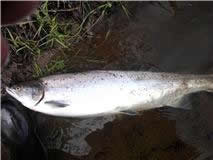Yesterday I had to be in Edinburgh, which meant that I missed a day of action at FCW. Although only two salmon were caught, both by FCW ghillie Moray Macfarlane (about which more laterin this blog), other rods saw fish, lost fish and suffered the usual range of tweaks and bumps from spring salmon not quite in the mood to engulf the fly. The water is clear and a very pale amber in colour but there is still sufficient water – a bulge around the sides of the ‘armchair rock’ in the centre of our webcam – to keep fish moving upstream, with the very occasional one taking the fly.
Moray Macfarlane’s two fish came from Frank’s Stream (10 lbs) and Tollmuir Pool (13 lbs). Of course Moray knows the water well, especially the lower two beats (Indies and Bogardo), and the best time to fish each pool. His approach to the Tollmuir Pool was from the right (S) bank and, after fishing down the stream, he hooked the fish in the main part of the pool opposite the big boulder, which is the main lie. He was fishing with one of Pete’s flies tied for Finavon following a discussion with me about the Finavon Whisp. My argument was that, because I am a poor exponent of the fly tying art, the same effect as a Finavon Whisp could be achieved by considerably reducing the amount of dressing on Pete’s Cascades and their variants. The result was a collection of beautifully tied flies commissioned specially for FCW. When Moray saw them he began to salivate (!), and immediately commissioned some for himself! Both his Tollmuir salmon and the Frank’s Stream one were caught on a Finavon Cascade lightly tied by Pete on silver Salar doubles (size 10).
Unless there is more rain I suspect that the fishing will become more difficult, but the weather forecast gives grounds for optimism. Whether we get rain or not the prospects for South Esk sea trout runs are starting to look very good indeed, especially now that there will be no deliberate killing of sea trout by the Usan nets. However, if we are to see more late spring MSW salmon, we will need more water.
TA
